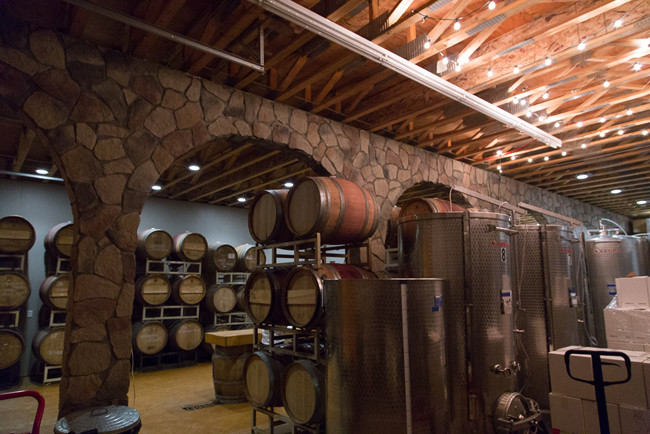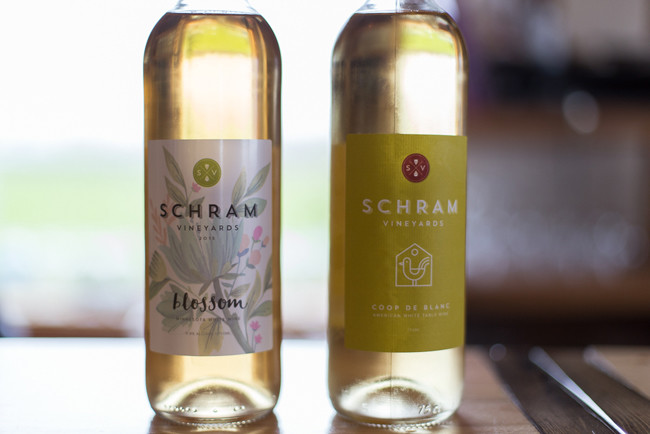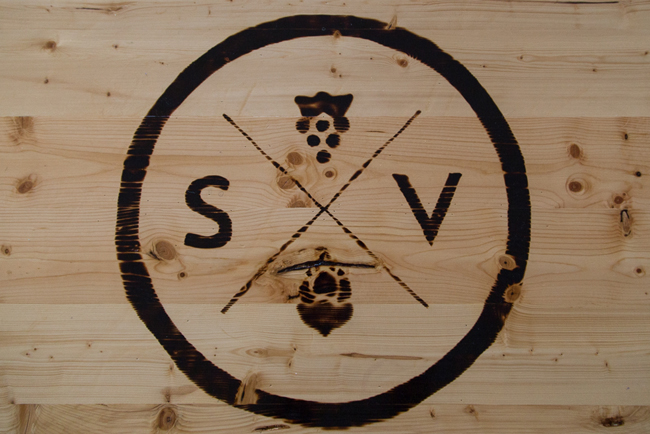
Sometimes, a local business manages to fly under the radar for months or even years despite offering a high-quality product. This has advantages for patrons: shorter lines, better selection, or that exhilarating, hidden-gem sensation. In some cases, there are advantages for the business, too, like the ability to perfect a recipe or develop a brand image before entering into the spotlight.
This is most certainly the case for Schram Vineyards Winery and Brewery in Waconia, which has garnered a consistent local following in the west metro since opening in 2013, but is poised to set the bar much higher this year. Owners Aaron and Ashley Schram (below) have doubled their winemaking capacity and increased their beer production sixfold this season.

Schram is the only combined winery and brewery for about 400 miles and one of only two vineyards consistently producing both beer and wine in the entire Midwest, the other being SchillingBridge Winery and Microbrewery in Nebraska. The legal classification of the business is far from simple; the operation is part farm, part winery, part brewery, and is therefore not classified as a taproom. In combination, the wine and beer draw a heterogeneous following to the tasting room, and yet the business doesn’t stir up much buzz among either the beer or wine crowds.

For one thing, Minnesota wine often suffers from an image problem. There is a misconception that cold-climate grapes — plants that have been developed to survive harsh winters and still produce grapes of use to vintners — make for bad wine. In reality, there are many successful, critically acclaimed wineries using these grapes, most of which have been meticulously developed at the University of Minnesota just for wine.
And from a beer perspective, urban and suburban breweries continue to experience a heyday while those on the outskirts and in rural places draw mainly locals and are forced to distribute in order to offer wider appeal. The exceptions are few: Dave’s BrewFarm and Oliphant Brewing in Wisconsin, and Toppling Goliath Brewing Co. in Decorah, Iowa.

The idea to make both beer and wine stems from the Schrams’ love for both beverages. Aaron’s passion for winemaking began in college, when he fermented ordinary grape juice into something resembling wine. From there he went on to do coursework through the University of Minnesota and spend time working at St. Croix Vineyards in Stillwater. After Aaron purchased a vessel for sparkling wine from a bankrupt winery in South Dakota, a friend remarked, “You’ve got half a brewery here.” Ashley, a beer lover, was in support of pursuing the idea.
Aaron is quick to point out the challenges of such a complex operation and admits that he is not immune to regret at times. Running a business that consists of a bar, farm, winery, brewery, warehouse, and distribution center can be maddening. “Think of the challenges of running a taproom: everything from supply chain to licensing, plus staffing and packaging. Then add to that growing grapes.” He gestures towards the windows that overlook several acres of farmland running gently downhill from the building to a row of lakefront homes. Schram grows multiple varieties of grapes on site and sources the remainder of the juice he needs from the West Coast.
“When I need grains, I just go down to BSG [Brewer’s Supply Group, Shakopee’s giant malt house that supplies breweries with malted barley and other grains],” he says, highlighting the major differences in sourcing his raw ingredients: grapes and grain, plus hops and yeast.

At the same time, he emphasizes that “wineries and breweries have more in common that people may think.” This is becoming especially true as the craft beer industry is adopting practices that are familiar to the wine world — critical evaluation, cellaring beer, and using appropriate glassware, for example. Even the trend toward increasing amounts of alcohol and imperial styles, followed by the rise of session ale, mirrors the changes in wine.

What sets Schram apart is not merely the fact that it offers more choices to consumers; it is the interplay of the beverages. “We have more in our arsenal when it comes to brewing,” says Aaron, pointing out the cohabitation of elements, specifically barrels and yeast, plus the wine itself.
Brewers have been turning to wine — whether in finished form, grapes, or barrels — for use in brewing for years. Legendary breweries such as Dogfish Head and Funkwerks pioneered this process. Recently, Indeed employed wine barrels to add sour notes and wood character to its Wooden Soul series.

In June, Schram plans to release a sour beer that contains sauvignon blanc. It will be a tart, refreshing sour, perfect for those new to sour beers or even to beer in general. Sour beers have a way of converting wine drinkers who may not enjoy other types of beers, a rewarding experience for the Schrams. Both Aaron and Ashley describe how much they enjoy seeing guests come for one product and leave with a growler or bottle of the other.
Schram is debuting its wine and beer club this year, and new releases like the sour will be available to club members about a week before the public may purchase them. Members will make quarterly pickups of beer or wine, with the opportunity to taste both products at the vineyard. Additionally, 750 milliliter bombers of the flagship beers plus many different wines are available in local liquor stores, and the Schrams hope to add more specialty bottled beers in the near future.

With oversight from Aaron, a team of about six brewers with diverse backgrounds creates the wide catalog of beer. During our visit, a dozen beers — ranging from pale straw to deep black — were on the menu. On the lighter side, the Cream Ale was a favorite. Initially, it comes across as bland, but after swallowing, a strong finish of Corn Nuts and Cheerios comes through, which is ideal for the style. It is very clean, meaning that it is free of fermentation errors and it leaves the palate quickly, almost in a lagerlike fashion. The Schram Weisse is textbook traditional in its flavor array, from clove to banana and even bubblegum. At 4.5 percent ABV, it is substantial but not heavy and lends itself to warmer afternoons. Finally, the Schram Farm Saison is another excellent choice with its faint pickling spice and fennel aroma and a bright citrus finish accented by the effervescent mouthfeel.
Hoppy beers are an area for some improvement, but they really don’t disappoint, either. The Runway Red was a top choice with bitterness dominating and caramel maltiness not far behind. It is similar to the House Red at Able Seedhouse and Brewery, but with more alcoholic punch, however subtle. The Double Barrel IPA, an imperial IPA, is pleasant but lacking in both bittering and aroma hops. The Puddle Hopper IPA suffers from the same issues, but to a lesser degree. It uses all Minnesota-grown hops from Hilltop Hops in Shakopee, and the brewers are learning what to expect from these local varieties in order to use them as well as possible.

Dark beers are powerful in their ability to stand out from one another. For a smoky offering, try the Smoking Aces Porter which has a much more natural smoke than most in the same style. The malt is smoked using beechwood in the traditional Rauchbeer style of Germany. The Mocha Monkey Coffee Ale is lighter than it sounds. It is classified as an English Brown Ale, which allows the coffee to come through naturally rather than relying on the coffee notes of the malt itself.
The brewing team is currently in the final phases of experimentation with fermenting beer in a concrete vessel traditionally reserved for wine. The first attempt was an IPA, and the next to hit the 7-bbl concrete tank will be a session IPA. This type of tank is very different from stainless steel or wooden barrels and is rare in brewing. The material adds minerality, as one can imagine, but it is also porous like wood, meaning it has its own way of breathing. Further implications for the taste of the beer are will be seen when the session IPA is released to club members June 4 and to the public on June 11.

White wines vary from semidry to semisweet, with several notable choices. For a light and subtle white, opt for the 2015 Sierra Victor, a pinot gris. It displays subtle pear notes and a soft finish and would be a perfect choice for sipping on its own. For something that is not as likely to be overwhelmed by food, the 2015 Coop de Blanc is a blend of four Minnesota grapes, including the well-known Frontenac Gris, plus Brianna, which has become known for its tropical fruit notes. The wine steers clear of being too sweet and is a good example of cold-climate wine.

The most unusual white we tried was the 2015 Blossom, with a distinct barnyard nose and an acidic apricot and pineapple taste that was immediately intriguing. It is an excellent and memorable sip. The blush, on the other hand, was ho-hum in comparison, with its light berry flavors and medium-light body.

Among the reds, two stand out for their ability to work alone or with a broad array of foods. The full-bodied, bold 2014 Bonfire is made with cabernet, merlot, and sangiovese grapes for an excellent balance of sweet berry notes and earthy oak. The 2014 Sangiovese is a single varietal with clear stone fruit and cherry notes and black peppercorn on the finish. It is warming, with a dry finish, and would work well with charcuterie or a margherita pizza.
Though you my be tempted to, do not skip dessert. Schram’s 2013 Last Course Dessert Wine falls far short of being cloyingly sweet as many in this category are. It contains fig aromas and flavors, with a brief dark chocolate note. The rich, portlike character doesn’t become overly viscous in the mouth, though, meaning it doesn’t overstay it’s welcome on the palate.
On the horizon for Schram is a beer made entirely from ingredients grown at the vineyard. Barley plants are going into the earth in the coming weeks, and hops have been in progress for several seasons. This fall, club members will be offered a unique opportunity to actually participate in brewing a beer made with the fresh hops grown at Schram. The hope is for the barley to be both grown and malted on site, something that is virtually unheard of.
Schram Vineyards, 8785 Airport Rd Waconia, MN 55387; 952.442.5105. Thu-Fri 5 p.m.-9 p.m., Sat noon-8p.m., Sun noon-5 p.m.



Scrham is just a bit west of where I live and as a house divided (I enjoy beer, my wife only wine) it is a wonderful compromise that doesn’t feel like a compromise! There is a food truck there to bolster their few snack offerings on a scheduled basis and bands from time to time. There is bocce anytime it isn’t pouring out!
Look, I like super fancy taprooms or ultra rare beers served out of loading docks too, but there’s something to being able to sit outside on a calm evening enjoying a beer at a vineyard of all places. Even better that it’s solid non-macro fare with a surprising variety to choose from and that’s not even getting into their wines (which are far more my wife’s purview.)